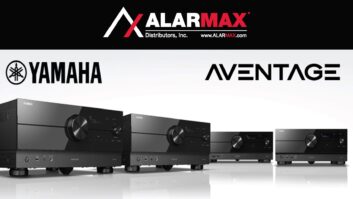PLAINVIEW, N.Y. — Elmo, which has been long regarded as a manufacturer of high-quality document-scanning and imaging products for the corporate and industrial markets, is preparing to venture into the consumer electronics market with a line of lightweight, portable data projectors as its first offerings.
Matt Takekoshi, Elmo USA president, told TWICE that the Japan-based manufacturer of industrial and education-centric security and document cameras is expanding its portfolio with an ultra-compact portable, lightweight LED-based DLP projector targeting corporate applications initially, with plans to shortly ramp up with two additional models targeting value-centric home theater consumers.
The company, which has been marketing products in the U.S. since 1973, turned the spotlight on the education market about five years ago with “total classroom solution products.”
“As far as we are concerned, the pico or mobile projector market is still not totally dominated by just a few companies,” Takekoshi said. “We see it as a natural fit for us getting into the market. Elmo has very strong optics technologies, and we develop and manufacture all of the optics we use in our products.”
The company’s first projector, called the Boxi MP-350 ($659 suggested retail), is the first Japanese, companydeveloped pico projector, he said. It is based on Texas Instruments’ mini DLP digital micro-mirror technology, and an LED light source.
The tiny projector, which measures 5.2 inches by 5.6 inches by 1.7 inches and weighs 1.1 pounds, outputs 300 lumens of brightness, which Takekoshi stressed “is a true number” and delivers a 10,000:1 contrast ratio.
It offers three display modes to tailor the WXGA (1,280 by 720) resolution to the optimal output for clear display of text and graphics; a cinema/game mode that automatically selects the settings to best display games and movies; and a photo mode, which optimizes the projector for the best reproduction of photographs and other images.
The projector will support a wide array of screen sizes, but Elmo advocates up to 68 inches for best display results in environments with ambient lighting.
The new projector features Elmo’s short-throw lens and adds built-in wireless Wi-Fi connectivity.
“Boxi provides an ideal combination of small size, big picture, bright image and wireless convenience,” Takekoshi said, adding that Elmo’s true-color reproduction capabilities helps separate the Boxi from the rest of the Pico projector class.
The Boxi also features a downloadable app (Boxi for Windows and Mac and Boxi Air for iPhones and iPads and Android) that enables direct playback popular mobile devices, and allows up to four users at once to project their images on the screen with Boxi play.
Additional connectivity options include HDMI and RGB, as well as a USB port for connecting to thumb drives or external hard drives.
Audio is delivered through a built-in 1-watt speaker.
Takekoshi said Elmo has selected Wynit to handle distribution into its expanding distribution channels, including CE retail.
Elmo is beginning a brand building campaign now to make its name more familiar to consumer audiences.
The Boxi MP-350, he said, has a feature package and price point that will probably be most attractive to corporate and education uses, but a second model, due to hit shelves at the end of August, and a third offering slated for the holiday timeframe will have greater appeal among home entertainment enthusiasts.
“Many consumers may find that they don’t need all of the features in the MP-350 that appeal to business users, so our next models will cut the price quite a bit,” he said. The new versions are slated to retail for around $559 and $459, respectively. They would sacrifice a VGA input and Wi-Fi, leaving only an HDMI input and audio output.
Elmo said Wynit is helping to develop the retail distribution for Boxi. Elmo is looking for retail partners that ideally can provide a physical storefront with trained sales support that can competently explain the advantages of its products.
“In order for anyone to sell pico projectors successfully today, I think there are three key elements — live display, well-trained sales team and demographic characteristics,” he said.












